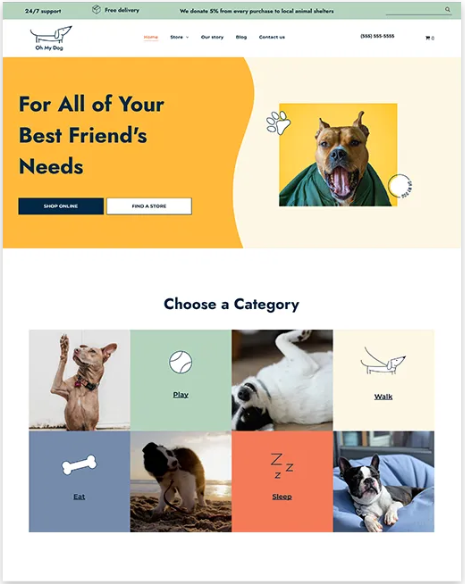Why Your Website Isn't Just a Pretty Face — It's Your Most Important Business Tool
Why Your Website Isn't Just a Pretty Face — It's Your Most Important Business Tool
I had a conversation last week with a business owner who'd just spent £800 on a "professional" website redesign. She was frustrated because it looked great in the portfolio screenshots, but three months later, nothing had changed for her business.
"I'm getting the same inquiries, the same confusion from clients, and I'm still spending half my day explaining things that should be obvious," she told me.
This conversation happens more often than you'd think. And it highlights a fundamental misunderstanding about what websites are actually for.
The Pretty Website Trap
Most business owners approach web design with the wrong question: "What should my website look like?"
It's natural to start there. We're visual creatures. We see a beautiful site and think, "I want something like that."
But here's what I've learned after working with dozens of businesses: A beautiful website that doesn't serve your business goals is just expensive decoration.
The right question is: "What job do I need my website to do?"
What Your Website Should Actually Do
Think of your website as a member of your team. Not the creative one in the corner making things look nice — the strategic one who:
Qualifies leads before they reach you Your ideal clients should be able to tell within seconds whether you're the right fit. Your website should attract the right people and (politely) discourage the wrong ones.
Answers your most common questions If you find yourself explaining the same things repeatedly — your process, your pricing structure, what's included — your website isn't working hard enough.
Guides people toward the next logical step Whether that's booking a consultation, downloading a guide, or making a purchase, visitors shouldn't have to guess what to do next.
Builds confidence in your expertise Through case studies, testimonials, or simply demonstrating that you understand their world and their problems.
The Signs Your Website Isn't Pulling Its Weight
Here are the red flags I see most often:
You hesitate to share your website link If you catch yourself saying "the website's a bit outdated" or "just ignore the design," that's your gut telling you something's wrong.
Clients book calls asking basic questions When prospects use your discovery call to figure out what you actually do, your messaging isn't clear enough.
You're getting inquiries from the wrong people If you're constantly explaining why you're not the right fit, your website is attracting the wrong audience.
You feel like you're constantly "selling" yourself When your website doesn't establish credibility, every conversation starts from zero trust.
The DIY Ceiling
Most successful business owners I know started with a DIY website. There's nothing wrong with that — it's smart to validate your business before investing heavily.
But there comes a point where DIY tools become a limitation rather than a solution.
You know you've hit that ceiling when:
- Your business has evolved but your website still describes what you used to do
- You've outgrown your original target audience but your messaging hasn't shifted
- You're trying to explain complex services through a template designed for simple portfolios
- You're spending more time managing your website than it's saving you
What "Strategic" Actually Means
When I talk about strategic web design, I'm not using buzzwords. I mean approaching your website like any other business investment:
Starting with clear objectives
What specific business problem are we solving? How will we measure success?
Understanding your audience deeply
Not just demographics, but their mindset when they land on your site. What convinced them to look for someone like you? What are they worried about?
Designing the user journey intentionally
Every page, every button, every piece of content serves a purpose in moving visitors toward your business goals.
Building for growth
Your website should be able to evolve with your business, not require a complete rebuild every two years.
The Investment Mindset
Here's the thing about treating your website as a business tool rather than a business card: it changes how you think about the investment.
A business card costs £50 and they get thrown away. A business tool pays for itself.
When a website is working properly, you should see:
- More qualified inquiries (fewer time-wasters)
- Shorter sales cycles (less explaining, more closing)
- Higher perceived value (better rates, less price objection)
- More referrals (people are proud to recommend you)
Starting With Strategy
Whether you're planning a redesign or building your first professional site, start with strategy:
- Audit what you have now — What's working? What questions do you still get asked?
- Define success — What would need to change for this investment to pay off?
- Map your customer journey — How do people currently find and choose you?
- Identify the gaps — Where are you losing potential customers in that journey?
Only then start thinking about design, features, and functionality.
The Bottom Line
Your website isn't a trophy. It's not there to impress other business owners or win design awards.
It's there to work for your business every day, turning visitors into customers and freeing you up to focus on what you do best.
If your current website isn't doing that job, the solution isn't always a complete rebuild. Sometimes it's clearer messaging. Sometimes it's better calls-to-action. Sometimes it's just organizing information in a way that matches how your customers actually think.
But it always starts with asking the right question: What job do you need your website to do?









